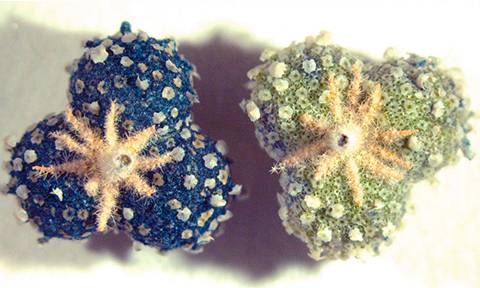
An interdisciplinary team of LAQV researchers from NOVA University Lisbon, University of Porto and University of Aveiro, unveiled the complex chemical structure of the medieval purple-blue dye used in the illumination of medieval manuscripts. The elucidation of the chemical structure of the medieval folium dye was a mystery until now, despite the efforts of several international research teams since the 20th century. The results obtained in this research work are an important contribution to the preservation of our cultural heritage and are now published in the high-impact journal Science Advances.
The study was developed by LAQV chemists and conservation and restoration researchers, specialists in the identification of natural products and the reproduction of medieval colors, and counted on the collaboration of a biologist from the University of Lisbon with extensive knowledge of Portuguese flora who supervised the collection of fruits and allowed to find and identify the mysterious small plant, Chrozophora tinctoria.
Of all the medieval dyes, folium is the only one whose chemical structure was unknown. It is extracted from the fruits of the Chrozophora tinctoria plant, native in Portugal, and its blue/purple was used during Antiquity and the Middle Ages, mainly in the illuminations of precious manuscripts.
The researchers studied several medieval documents and based on the detailed descriptions selected from three medieval treatises describing the uses of this dye, they determined the best time for the collection of the species and the best way to extract the dye from the plant, found in Southern Portugal (Granja/Mourão). The extracts obtained showed a blue dye as the main chromophore. The chromophore, the molecule responsible for color, was isolated, purified and characterized through a multi-analytical methodology. The purification and characterization were challenging until optimum conditions were reached. The researchers called chrozophoridine to the isolated chromophore.
Chrozophoridine was used in the past to make a beautiful blue dye in medieval illuminations and “now after determining the structure it is concluded that it is neither an anthocyanin, found in many blue flowers and fruits, nor indigo, the most stable natural blue dye, but a class of its own", concludes Maria João Melo, professor and researcher of LAQV at FCT NOVA and leader of the published study.
In cultural heritage, understanding and preventing degradation mechanisms involves elucidating the dye chemical structure. Only in this way, it will be possible to identify folium in artworks and study its properties, enabling new conservation strategies.
Access the full article "A 1000-year-old mystery solved: Unlocking the molecular structure for the medieval blue from Chrozophora tinctoria, also known as folium."
Check the video about this study: